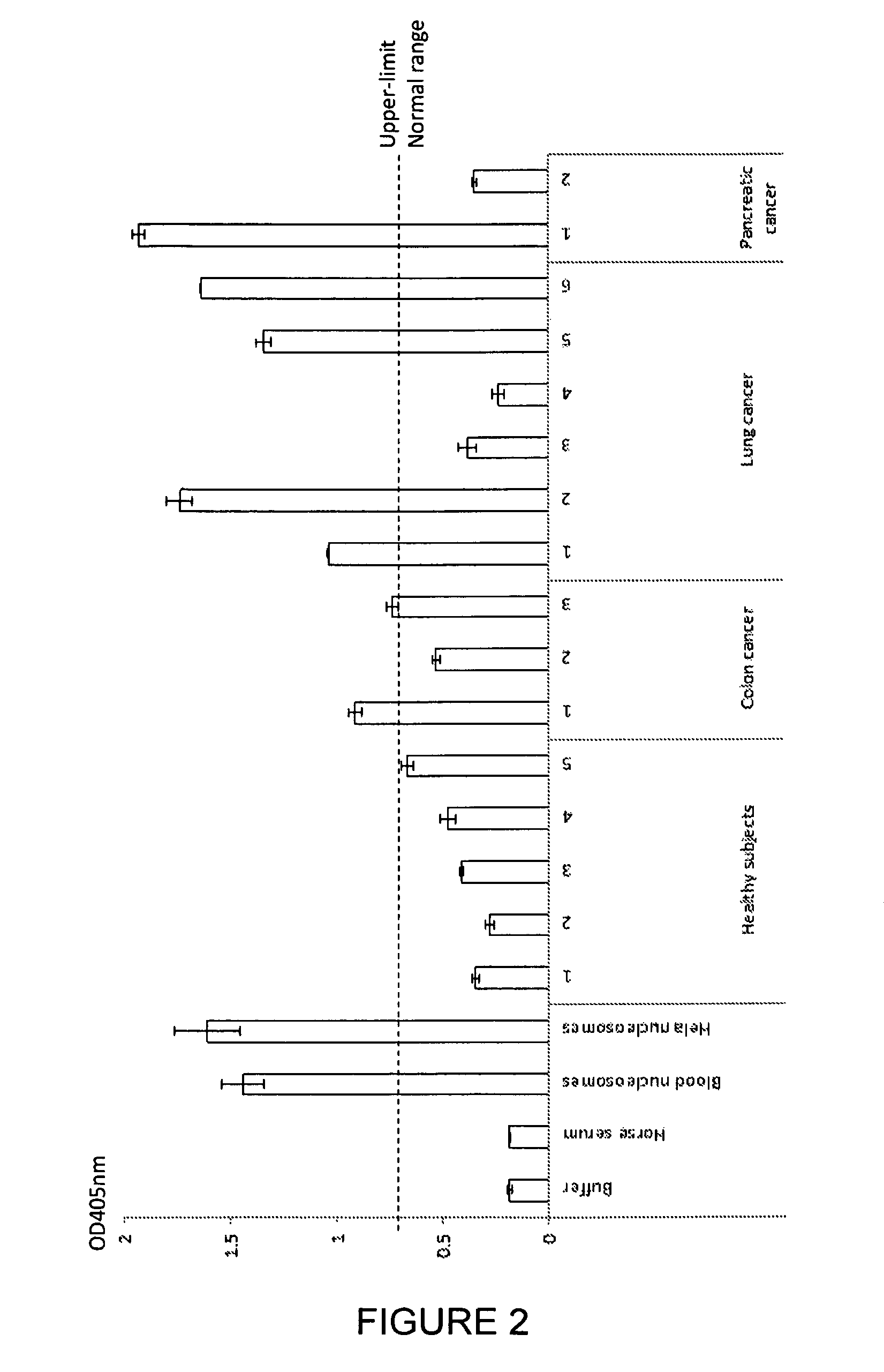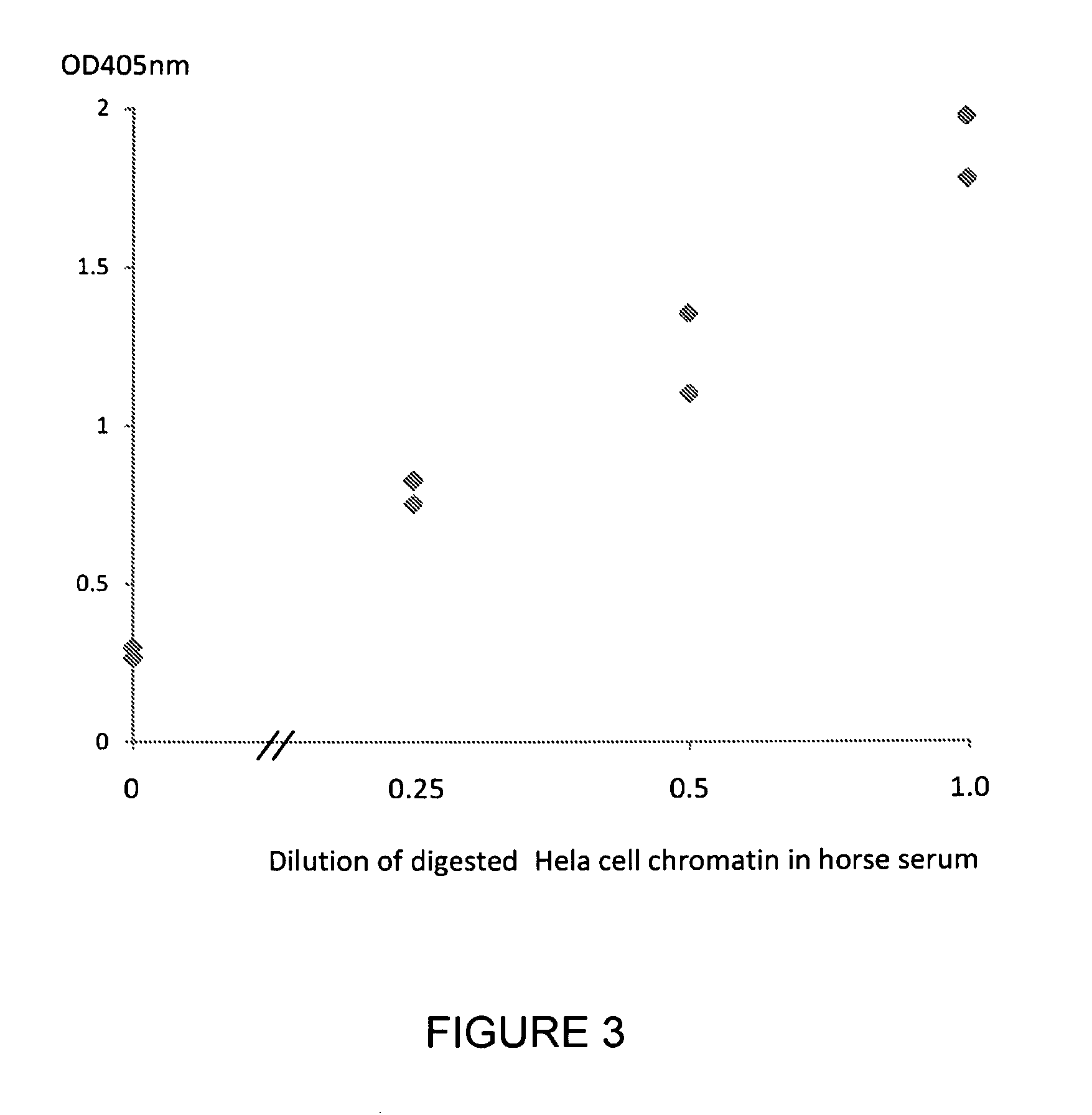Method for detecting nucleosome adducts
a nucleosome and nucleosome technology, applied in the field of nucleosome adduct detection, can solve the problems of tissue sample collection invasive involving surgery or biopsy, nucleosome and dna measurement in serum or plasma not agreeing well, and testing not agreeing with each other
- Summary
- Abstract
- Description
- Claims
- Application Information
AI Technical Summary
Benefits of technology
Problems solved by technology
Method used
Image
Examples
example 1
[0224]Serum samples were taken from 5 healthy subjects, 3 subjects with colon cancer, 6 subjects with lung cancer and 2 subjects with pancreatic cancer. A commercially available nucleosome preparation produced by digestion of chromatin extracted from Hela cells, in which the DNA and proteins in the nucleosome are cross-linked for stability, was serially diluted in horse serum. A nucleosome preparation in human blood was prepared according to the method of Holdenrieder (*Holdenrieder et al; 2001). These samples and preparations were assayed in duplicate for nucleosome-EZH2 adduct by the method of the invention. Neat commercially available horse serum produced for use in tissue culture was also assayed as a negative control sample containing no nucleosomes or nucleosome adducts.
[0225]The ELISA method used a solid phase anti-histone capture antibody that binds intact nucleosomes and a biotinylated monoclonal anti-EZH2 detection antibody as follows: A solution of anti-histone antibody i...
example 2
[0226]Serum samples were taken from 5 healthy subjects, 3 subjects with colon cancer, 6 subjects with lung cancer and 2 subjects with pancreatic cancer. A commercially available nucleosome preparation produced by digestion of chromatin extracted from Hela cells, was serially diluted in horse serum. A nucleosome preparation in human blood was prepared according to the method of Holdenrieder (*Holdenrieder of al; 2001). These samples and preparations were assayed in duplicate for nucleosome-HMGB1 adduct by the method of the invention. Neat horse serum was also assayed as a negative control sample containing no nucleosomes or nucleosome adducts.
[0227]The ELISA method used a solid phase anti-histone capture antibody that binds intact nucleosomes and a biotinylated monoclonal anti-HMGB1 detection antibody as follows: A solution of anti-histone antibody in 0.1M phosphate buffer pH 7.4 was added to microtitre wells (100 μL / well) and incubated overnight at 4° C. to coat the wells with captu...
example 3
[0233]A nucleosome-PR ELISA assay was carried out using the method of Example 1 above except that the biotinylated antibody used was directed to bind the progesterone receptor (PR). The results are shown in FIG. 6.
PUM
| Property | Measurement | Unit |
|---|---|---|
| Optical Density | aaaaa | aaaaa |
| Optical Density | aaaaa | aaaaa |
| pH | aaaaa | aaaaa |
Abstract
Description
Claims
Application Information
 Login to View More
Login to View More - R&D
- Intellectual Property
- Life Sciences
- Materials
- Tech Scout
- Unparalleled Data Quality
- Higher Quality Content
- 60% Fewer Hallucinations
Browse by: Latest US Patents, China's latest patents, Technical Efficacy Thesaurus, Application Domain, Technology Topic, Popular Technical Reports.
© 2025 PatSnap. All rights reserved.Legal|Privacy policy|Modern Slavery Act Transparency Statement|Sitemap|About US| Contact US: help@patsnap.com



